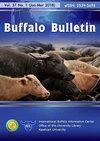Assessing the acceptability of hormone-based estrus induction / synchronization protocols to overcome anestrus in buffaloes
IF 0.2
4区 农林科学
Q4 AGRICULTURE, DAIRY & ANIMAL SCIENCE
引用次数: 0
Abstract
Five hundred dairy households in the rural areas of Punjab state were interviewed through comprehensively designed questionnaires to assess the knowledge and experience of farmers regarding the hormone-based strategies to overcome anestrus and getting the buffaloes pregnant. About 81.8% dairy households were unaware (P<0.05) about any estrus induction or synchronization hormonal protocol and majority (65.5%) of these belonged to households with <5 animals. Out of households having awareness about hormonal protocol use in buffaloes, the majority (58.2%) belonged to households with >15 animal. Out of dairy farmers using hormonal protocols, the proportion of illiterate was 14.8%. Out of dairy farmers not aware about hormonal protocols, the proportion of illiterate was 52.3%. Data analysis of 91 dairy households who had used hormonal protocols revealed summer (65.9%) and anestrus (82%) as the major underlying reasons for their use in buffaloes. Low success rate (20.2%), high cost (50%) and non-availability of doctor (29.7%) were the reasons for the irregular use of hormonal protocols. The success rate of hormonal protocols under field condition in terms of conception was 47.1%. In summary, the major bottlenecks in acceptability of hormone-based therapeutics strategies under filed conditions are illiteracy, high cost of therapeutics strategies and lack of awareness in buffalo farmers especially in households with <5 animals.评估以激素为基础的发情诱导/同步方案的可接受性,以克服水牛的不发情
通过综合设计的问卷,对旁遮普邦农村地区的500个奶农家庭进行了访谈,以评估农民对以激素为基础的策略克服发情和使水牛怀孕的知识和经验。约81.8%的奶牛家庭不知道任何发情诱导或同步激素方案(P<0.05),其中大多数(65.5%)属于有5头奶牛的家庭。在了解水牛激素使用方案的家庭中,大多数(58.2%)属于拥有15头动物的家庭。在使用激素方案的奶农中,文盲的比例为14.8%。在不了解激素方案的奶农中,文盲比例为52.3%。对91个使用激素方案的奶牛家庭的数据分析显示,夏季(65.9%)和发情(82%)是水牛使用激素的主要潜在原因。不规律使用激素方案的原因有:成功率低(20.2%)、费用高(50%)和无医生(29.7%)。野外条件下激素方案受孕成功率为47.1%。总之,在野外条件下接受激素治疗策略的主要瓶颈是文盲、治疗策略的高成本和水牛农民缺乏认识,特别是在有5只动物的家庭中。
本文章由计算机程序翻译,如有差异,请以英文原文为准。
求助全文
约1分钟内获得全文
求助全文
来源期刊

Buffalo Bulletin
AGRICULTURE, DAIRY & ANIMAL SCIENCE-
CiteScore
0.50
自引率
0.00%
发文量
53
审稿时长
>12 weeks
期刊介绍:
Buffalo Bulletin is published quarterly in January-March, April-June, July-September and October-December. Contributions on any aspect of research or development, progress reports of projects and news on buffalo will be considered for publication in the bulletin.
 求助内容:
求助内容: 应助结果提醒方式:
应助结果提醒方式:


